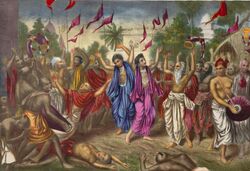Religion:Nagar Kirtan
Nagar Kirtan also Nagara Sankeerthane (Sanskrit: नगर कीर्तन, Bengali: নগর কীর্তন, Gurmukhi: ਨਗਰ ਕੀਰ੍ਤਨ, Kannada; നഗര സങ്കീർത്തനേ) is a dharmic tradition involving the processional singing of holy hymns by a group in a residential area.[1][2]
Chaitnaya Mahaprabhu is credited with introduction of custom of Nagar Kirtan which included singing not only lyrical verses dedicated to Lord Krishna but also chanting and singing them repetitively on the streets of city in form of a procession.[3]
Hinduism
In Hinduism, Bengali saint Chaitanya Mahaprabhu[4] propagated ideas of Bhakti through Samkirtan (collective recitation of the hymn) and Nagar Kirtan (Kirtan in form of religious processions), [5] and is credited in the Vaishnava tradition with introduction of the custom which included singing not only lyrical verses dedicated to Lord Krishna but also chanting and singing them repetitively on the streets of city in form of a procession.[6] The congregational singing of Chaitanya in the forms of Sankirtan and Nagar Kirtan always remained wrapped in the folk tunes of the devotees amidst the boisterous booming of drums and cymbals.[7] A video of a Nagara Sankeerthane Raghu Leela School of Music in February 2021 performing Nagara Sankeerthane at the Sri Seetha Rama temple in Ashwathapura of the Dakshina Kannada district, went viral on social media with millions of views.[1]
Sikhism
| Script error: No such module "Image array". Nagar Kirtans |
Nagar Kirtan, in Sikhism, is customary in the festival of Vaisakhi. Traditionally, the procession is led by the saffron-robed Panj Piare (the five beloved of the Guru), who are followed by the Guru Granth Sahib, the holy Sikh scripture, which is placed on a float.[8]
Commonly, members of the procession are unshod in deference to the displayed scripture. Likewise, many cover their heads and don the colour saffron or orange. The road before the procession is cleared by Sewadars. Bystanders bow their heads to the scripture. Food may be provided to them from floats that follow the Scripture or from stationary points near the vicinity of the procession.[9] The procession concludes at the Gurudwara with Ardas (pray).[10]
See also
References
- ↑ 1.0 1.1 ""Nagara Sankeerthane" By RLSM Mysuru Students Goes Viral On Social Media". http://www.businessworld.in/article/Nagara-Sankeerthane-by-RLSM-Mysuru-students-goes-viral-on-social-media/09-02-2021-375387/.
- ↑ Satija, Garima. "'More Reasons To Fall In Love With You India', Kangana Ranaut On Viral Nagara Sankeerthane Clip". https://www.indiatimes.com/entertainment/celebs/more-reasons-to-fall-in-love-with-you-india-kangana-ranaut-on-viral-nagara-sankeerthane-clip-535106.html.
- ↑ Bhatia, Varuni (2017) (in en). Unforgetting Chaitanya: Vaishnavism and Cultures of Devotion in Colonial Bengal. Oxford University Press. ISBN 978-0-19-068624-6. https://books.google.com/books?id=824sDwAAQBAJ&q=nagar+kirtan+Chaitanya&pg=PA79.
- ↑ Damen, Frans L. (1983) (in en). Crisis and Religious Renewal in the Brahmo Samaj, 1860-1884: A Documentary Study of the Emergence of the "New Dispensation" Under Keshab Chandra Sen. Department Oriëntalistiek, Katholieke Universiteit Leuven. ISBN 978-90-70192-12-9. https://books.google.com/books?id=qxVlAAAAMAAJ&q=nagar+kirtan+Chaitanya.
- ↑ Mallik, Basanta Kumar (1996) (in en). Medieval Orissa: Literature, Society, Economy, Circa 1500-1600 A.D.. Mayur Publications. https://books.google.com/books?id=4zpuAAAAMAAJ&q=nagar+kirtan+Chaitanya.
- ↑ Bhatia, Varuni (2017) (in en). Unforgetting Chaitanya: Vaishnavism and Cultures of Devotion in Colonial Bengal. Oxford University Press. ISBN 978-0-19-068624-6. https://books.google.com/books?id=824sDwAAQBAJ&q=nagar+kirtan+Chaitanya&pg=PA79.
- ↑ (in en) Current Thoughts on Sikhism. Institute of Sikh Studies. 1996. ISBN 978-81-85815-01-5. https://books.google.com/books?id=13PXAAAAMAAJ&q=nagar+kirtan+Chaitanya.
- ↑ Nagar Kirtan 16 June 2012
- ↑ seke, 2014
- ↑ seke, 2014


